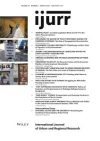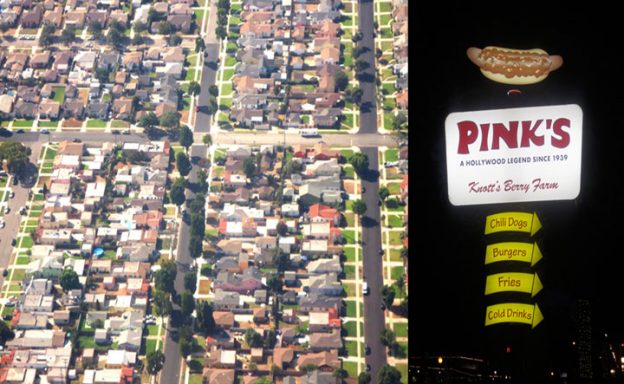Picture Above: Aerial photograph flying into Los Angeles in September 2012. This western LA neighbourhood, most likely a sector of Inglewood, represents the dense post-suburban cityscape that marks most of the city today. The sign for Pink’s Hot Dogs stand at Knott’s Berry Farm in Buena Park, California combines the legendary Hollywood eatery’s street cred with one of the region’s oldest entertainment complexes that grew indeed out of an existing berry farm. (Photos by Roger Keil, 2011-2012)
Los Angeles
Virtual Issue
Long in the shadow of its continental rivals New York and Chicago, and by far not as extensive an object of urban studies as Philadelphia, Boston, Atlanta or the legendary New Haven, Connecticut, Los Angeles has, during the last generation, come into its own as a site for and place of origin of important research on the city.
Until Mike Davis’s game changing City of Quartz (1990), the truly important works of critical urban research on Los Angeles (amongst many technical and descriptive studies) could be counted on one hand. The defining study, flawed as it was, remained for many decades Anton Wagner’s Los Angeles: Zweimillionenstadt in Südkalifornien, (1935). Two magnificent pieces of work that could not be more different from each other marked a new era of L.A. studies with path-breaking new perspectives on the burgeoning Southern California metropolis, first in 1967, Robert Fogelson’s The Fragmented Metropolis and shortly after in 1971, Reyner Banham’s The Architecture of Four Ecologies. Just before the publication of Davis’s masterwork, Edward Soja revolutionized the way geographers and urban scholars would look at space, time and the city in his Postmodern Geographies (1989). That Soja’s venture into poststructuralism and postmodernism started (and ended) in Los Angeles was no accident. For the next two and a half decades a rich field of urban research was opened up in Southern California that changed the way we see the urban, and the world. These seminal works were followed, in the 1990s and 2000s by an impressive wave of new scholarship that put Los Angeles on the global map of urban studies in monographs, edited volumes and countless journal articles too many to mention in this brief review. As Los Angeles grew in significance as the “Capital of the Pacific Rim”, a “Los Angeles School” of urban and regional research claimed to revolutionize urban research fundamentally once and for all.
When IJURR was founded in the 1970s, Los Angeles was just beginning to experience the crisis that would define the final quarter of the 20th century, characterized by the deindustrialization of what once used to be one of the most extensive Fordist production complexes and the almost complete transformation into a neo-industrial, post-Fordist dreamscape of sweatshops, flexible production systems and a seemingly unending flow of immigrant capital and labour. The new arrangements were punctured by the Rebellion of April 1992 which marked yet another turning point in the history of the city and the region. For some, those defining decades in Los Angeles history and geography heralded more than just local events: A new type of city and a new type of urban studies were supposedly in the making that made L.A. the model of many if not most urban places everywhere.
IJURR, while not the natural journal to host the upheavals of the cultural, linguistic, poststructural and spatial turns that originated partly in Los Angeles as city and intellectual place, did provide a platform for some of the major debates that sprang from that period. Los Angeles has been in IJURR from the beginning to the current time. In the brief selection below, we have the pleasure to unearth a few of the classical papers published in our journal and present them as a joint collection for the attendants of this year’s AAG meetings and beyond.
The selection below comes from a longer list of publications in IJURR that had Los Angeles as origin or subject. I had to make some hard choices given the limits to this format of a digital edition. In the end, I am presenting three categories of papers from more than 30 years of journal output.
In the first group of papers, we find the classics. These are examples of the signal effects coming from Los Angeles that ignited a new generation of urban scholars to look beyond the national, Fordist models of urbanization and to explore new categories of city formation. World or global city research arguably has its origin in the seminal paper by Friedmann and Wolff. Scott’s piece on flexible production systems was crucial for our understanding of restructured urban and regional economic geographies after Fordism. Much of that development and of that understanding had its origin in Southern California. Don Parson’s two papers present work by one of Southern California’s most unique, independent and radical thinkers. Mapping the mid- and end of century alike, they grapple with the main categories of urban life in the city’s restructuring. Finally, Nicholls’s reflective article on the Los Angeles School summarizes some of the core intellectual currents that defined L.A. during the past generation.
The second category deals with politics and movements. To highlight work in this area is a bit indulgent as I have worked on these matters myself. But I do believe that the selections here give a good impression of the significance of Los Angeles, considered by some not so profoundly political as other American cities, as a tremendously important site of action and policy in the urban realm. The classical studies by Haas and Heskin, and Shearer and the more current piece by Nicholls examine pathbreaking movements in the history of US progressive neighbourhood, labour and urban politics. The contributions by Boudreau and Keil warn against a simplistic celebration of local democracy in a context set by the legacy of the Lakewood plan, political segregation and Proposition 13.
Our final five papers deal with social structures, diversity, marginality and privilege. They are also the most recent set of papers with the first one marking the analysis of the conditions preceding the Rebellion of 1992 by Johnson, Farrell and Oliver. Ivan Light’s paper on immigrant place entrepreneurs stands for, but also stands out of, a strong tradition of scholarship published in IJURR that has dealt with economic and social aspects of immigration to Los Angeles. The papers by Reese, Deverteuil, Thach and by Marr go the core of the city and its perennial problems of marginality, homelessness and poverty. The final selection features current work by LeGoix and Vesellinov on the phenomenon of gated communities. This last section also nicely demonstrates the wide disciplinary and methodological spectrum of high quality research published in IJURR on Los Angeles: from social geography, to sociology, critical anthropology and econometrics. There is something for everyone in IJURR’s Los Angeles. And although Soja (1989:222), in likening it to Borges’s Aleph, calls Los Angeles “exceedingly tough-to-track, peculiarly resistant to conventional description”, many people have tried and keep trying to blaze new trails in making sense of Los Angeles. IJURR is pleased to have provided one possible and relevant place for this work to appear.
Roger Keil is a former co-editor of IJURR and the author of Los Angeles: Globalization, Urbanization and Social Struggles. Chichester: Wiley, 1998.
Foundations/Context
World City Formation: An Agenda for Research and Action
John Friedmann and Goetz Wolff (1982)
The Development of Redevelopment: Public Housing and Urban Renewal in Los Angeles
Don Parson (1982)
Flexible Production Systems and Regional Development: The Rise of New Industrial Spaces in North America and Western Europe
A.J. Scott (1988)
The Search for a Centre: the Recomposition of Race, Class and Space in Los Angeles
Don Parson (1993)
The Los Angeles School: Difference, Politics, City
Walter J. Nicholls (2011)
Politics and Movements
Community Struggles in Los Angeles
Gilda Haas and Allan David Heskin (1981)
Citizen Participation in Local Government: The Case of Santa Monica, California
Derek Shearer (1984)
Governance Restructuring in Los Angeles and Toronto: Amalgamation or Secession
Roger Keil (2000)
Questioning the use of ‘Local Democracy’ as a Discursive Strategy for Political Mobilization in Los Angeles, Montreal and Toronto
Julie-Anne Boudreau (2003)
Forging a ‘New’ Organizational Infrastructure for Los Angeles’ Progressive Community
Walter J. Nicholls (2003)
Social Structures, Diversity, Marginality, Privilege
Seeds of the Los Angeles Rebellion of 1992
James H. Johnson, Walter C. Farrell Jr and Melvin L. Oliver (1993)
Immigrant Place Entrepreneurs in Los Angeles, 1970-99
Ivan Light (2002)
‘Weak-Center’ Gentrification and the Contradictions of Containment: Deconcentrating Poverty in Downtown Los Angeles
Ellen Reese, Geoffrey Deverteuil and Leanne Thach (2010)
Pathways out of Homelessness in Los Angeles and Tokyo: Multilevel Contexts of Limited Mobility amid Advanced Urban Marginality
Matthew D. Marr (2012)
Gated Communities and House Prices: Suburban Change in Southern California, 1980–2008
Renaud Le Goix and Elena Vesselinov (2013)

